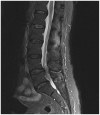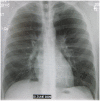Spinal Epidural Abscess
- PMID: 37465609
- PMCID: PMC10332528
- DOI: 10.21980/J8T938
Spinal Epidural Abscess
Abstract
Audience: The aim of this simulation case is to educate senior medical students, resident physicians, and advanced practice providers on the recognition, diagnosis, and management of spinal epidural abscesses. This scenario is most applicable to the emergency medicine setting but can be applied to the outpatient office or urgent care settings.
Introduction: Spinal epidural abscess is an infection leading to an epidural collection of purulent material. This uncommon condition is estimated to occur less than 12 times per 100,000 hospital admissions.1,2 However, this infection can lead to devastating neurological sequelae via cord compression, spinal vascular interruption, and inflammatory etiologies;3,4 thus, prompt diagnosis is essential. Unfortunately, spinal epidural abscesses may be difficult to identify clinically due to variable clinical presentations. The goal of this scenario is to increase awareness of this critical diagnosis.Detailed history-taking to identify risk factors will aid in the recognition of spinal epidural abscesses. Many of the risk factors are related to increased infectious risk from hematogenous spread, iatrogenic inoculation, or direct extension.1 Individuals with conditions including intravenous (IV) drug use, alcohol abuse, diabetes, human immunodeficiency virus (HIV), cancer, hepatic disease, renal disease, and other immunocompromising conditions are at increased risk of developing epidural abscesses.1 Primary infectious sources include dental abscesses, endocarditis, vertebral osteomyelitis, and soft tissue infections. Spinal procedures including spinal surgeries, paraspinal injections, and placement of epidural catheters or stimulators can also predispose to infection.2,4Classic symptoms for spinal epidural abscesses include fever, back pain and neurological changes.1,5 Back pain is the most frequent presenting symptom, occurring about 70%-90% of the time.1 However, fever is the least frequent presenting symptom4 and neurological findings only occur in about one-third of cases.2 Neurological symptoms include motor weakness, sensory changes, urinary retention, overflow urinary incontinence, bowel dysfunction, hyperreflexia, radicular pain, spinal shock or cauda equina syndrome.1,4Laboratory findings may include systemic leukocytosis and elevated inflammatory markers. Whereas leukocytosis is estimated to be present in two-thirds of cases,2 Davis, et al. showed that with the concurrent presence of a risk factor, an elevated erythrocyte sedimentation rate (ESR) had 100% sensitivity and 67% specificity for spinal epidural abscesses.5Magnetic resonance imaging (MRI) with gadolinium contrast is the preferred imaging modality for diagnosing spinal epidural abscesses. Computed tomography (CT) with myelography can be considered if MRI is contraindicated.1 Given that abscesses may be multifocal, further spinal imaging beyond a single spinal segment should be considered during evaluation. Lumbar puncture is not recommended due to risk of iatrogenic infectious spread.Treatment of epidural abscesses includes obtaining blood cultures and prompt antibiotic administration with early surgical evaluation to determine if operative intervention is warranted. Staphylococcus aureus is the most common microbial cause, contributing to about two-thirds of cases.3,4 Other microbial causes include coagulase-negative Staphylococcus (ie, Staphylococcus epidermidis), Streptococcus, gram-negative bacilli (ie, Pseudomonas aeruginosa and E. coli), and less commonly, anaerobic bacteria, fungi, mycobacteria and parasites.1,2 Empiric antibiotic treatments generally include vancomycin and a third- or fourth- generation cephalosporin.2,4This simulation session will highlight the importance of recognizing and aggressively treating this uncommon but potentially devastating condition.
Educational objectives: After this simulation case, learners will be able to diagnose and manage patients with spinal epidural abscesses. Specifically, learners will be able to:Obtain a detailed history, including past infectious, surgical, procedural and social history to evaluate for epidural abscess risk factors. Describe clinical signs and symptoms of spinal epidural abscesses and understand that initial clinical presentations can be variable.Perform a focused neurological exam including evaluation of motor, sensory, reflexes, and rectal tone.Order appropriate laboratory testing and imaging modalities for spinal epidural abscess diagnosis, including a post-void bladder residual volume.Select appropriate antibiotics for empiric treatment of spinal epidural abscess depending on patient presentation.Disposition the patient to appropriate inpatient care.
Educational methods: The authors conducted this simulation case with a standardized patient. We encourage inclusion of a standardized patient versus a mannequin to provide appropriate motor and sensory exams. For those without a standardized patient program, the authors suggest utilizing a faculty member as the patient. Regardless of individual used, it is strongly recommended that facilitators rehearse the case with the individual in the patient role ahead of time in order to ensure that their performance reflects an accurate neurologic exam. A debriefing session and small-group discussion followed the simulation to review the clinical presentation, diagnosis, management, and treatment of spinal epidural abscesses. This case can also be adapted as an oral boards case.
Research methods: Residents were provided a survey at the completion of the debriefing session to rate different aspects of the simulation, as well as to provide qualitative feedback on the scenario. This survey is specific to our institution's simulation center.
Results: While qualitative feedback from the residents was positive, it was viewed as a straightforward case. Our initial presenting symptom was difficulty ambulating with a fever at home, if asked. The residents appreciated performing a neurologic exam on a standardized patient versus attempting this on a mannequin.Our simulation center's feedback form is based on the Center of Medical Simulation's Debriefing Assessment for Simulation in Healthcare (DASH) Student Version Short Form with the inclusion of required qualitative feedback if an element was scored less than a 6 or 7. This session received all 7 scores (extremely effective/outstanding) other than one 5 score for the element assessing if the instructor set the stage for an engaging learning experience. The learner's feedback for this 5 score was "kinda went right into the case which was ok." Our form also includes an area for general feedback about the case at the end. Comments included "Great sim. Expert case writing," "Fun case and learned a lot," and "Great case! Appreciated feedback on consulting and the difficult consultant situation."
Discussion: This is a cost-effective method for reviewing epidural abscess. We chose a chief complaint and history that was slightly atypical from "classic" presentations, but not so esoteric that the residents felt cheated at the end of the scenario. When using a standardized patient in a scenario that may involve a sensitive physical exam, we review with learners and the standardized patient what expectations are during the pre-brief session. For example, residents may say, "we would like to check to see if rectal tone is intact," and then the standardized patient would verbalize back the expected physical exam findings.
Topics: Medical simulation, spinal epidural abscess, spinal cord compression, infectious disease.
© 2020 Lou, et al.
Similar articles
-
Lightning Strike.J Educ Teach Emerg Med. 2022 Jan 15;7(2):S78-S106. doi: 10.21980/J8SD2M. eCollection 2022 Apr. J Educ Teach Emerg Med. 2022. PMID: 37465437 Free PMC article.
-
Cardiac Tamponade.J Educ Teach Emerg Med. 2020 Oct 15;5(4):S84-S107. doi: 10.21980/J81D1D. eCollection 2020 Oct. J Educ Teach Emerg Med. 2020. PMID: 37465332 Free PMC article.
-
Pilot Medical Certification.2023 Feb 6. In: StatPearls [Internet]. Treasure Island (FL): StatPearls Publishing; 2025 Jan–. 2023 Feb 6. In: StatPearls [Internet]. Treasure Island (FL): StatPearls Publishing; 2025 Jan–. PMID: 33620822 Free Books & Documents.
-
Bacterial spinal epidural abscess. Review of 43 cases and literature survey.Medicine (Baltimore). 1992 Nov;71(6):369-85. Medicine (Baltimore). 1992. PMID: 1359381 Review.
-
Spinal epidural abscess in hemodialysis patients: report of three cases and review of the literature.Am J Kidney Dis. 1996 Jan;27(1):75-83. doi: 10.1016/s0272-6386(96)90033-5. Am J Kidney Dis. 1996. PMID: 8546141 Review.
Cited by
-
Intradural Abscess of the Thoracic and Lumbar Spine.Cureus. 2024 Mar 6;16(3):e55650. doi: 10.7759/cureus.55650. eCollection 2024 Mar. Cureus. 2024. PMID: 38586772 Free PMC article.
-
Iatrogenic Side Effects of Pain Therapies.Cureus. 2023 Sep 2;15(9):e44583. doi: 10.7759/cureus.44583. eCollection 2023 Sep. Cureus. 2023. PMID: 37790027 Free PMC article. Review.
-
Unusual case of staphylococcus epidermidis-induced spinal epidural abscess in an adolescent: Clinical insights and diagnostic considerations.Radiol Case Rep. 2025 Mar 15;20(6):2699-2703. doi: 10.1016/j.radcr.2025.02.051. eCollection 2025 Jun. Radiol Case Rep. 2025. PMID: 40151277 Free PMC article.
References
-
- Tanski ME, Ma OJ. Central nervous system and spinal infections. In: Tintinalli JE, Stapczynski JS, Ma OJ, Yealy DM, Meckler GD, Cline DM, editors. Tintinalli’s Emergency Medicine: A Comprehensive Study Guide. 8th ed. New York, NY: McGraw-Hill Education; 2016. [Accessed April 15, 2019]. accessmedicine.mhmedical.com/content.aspx?aid=1121512340 .
-
- Sexton DJ, Sampson JH. Spinal epidural abscess. In: Calderwood SB, editor. UpToDate. Waltham, Mass: UpToDate; [Accessed Dec 27, 2019]. https://www.uptodate.com/contents/spinal-epidura-labscess. Updated Jun 25, 2019.
LinkOut - more resources
Full Text Sources
Miscellaneous



